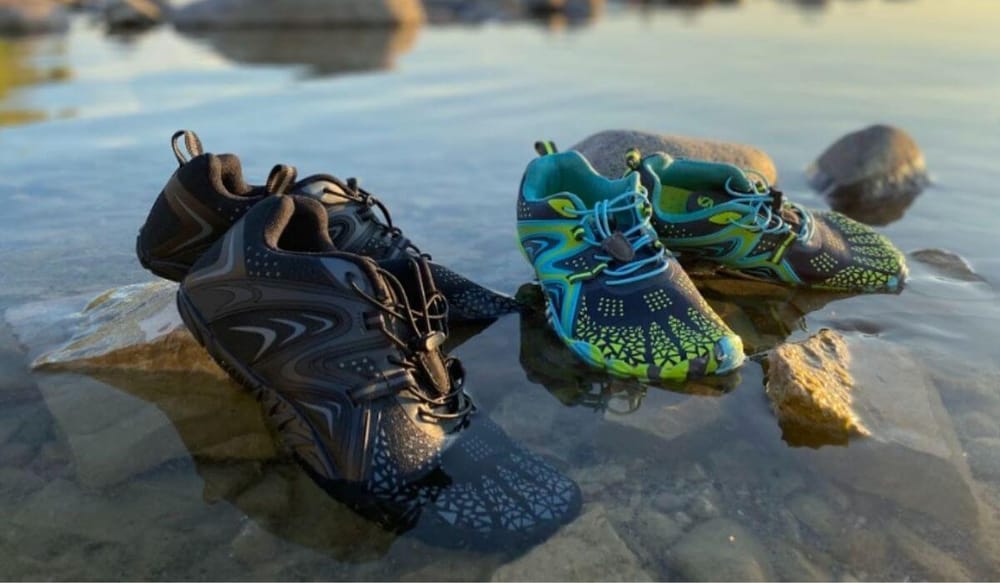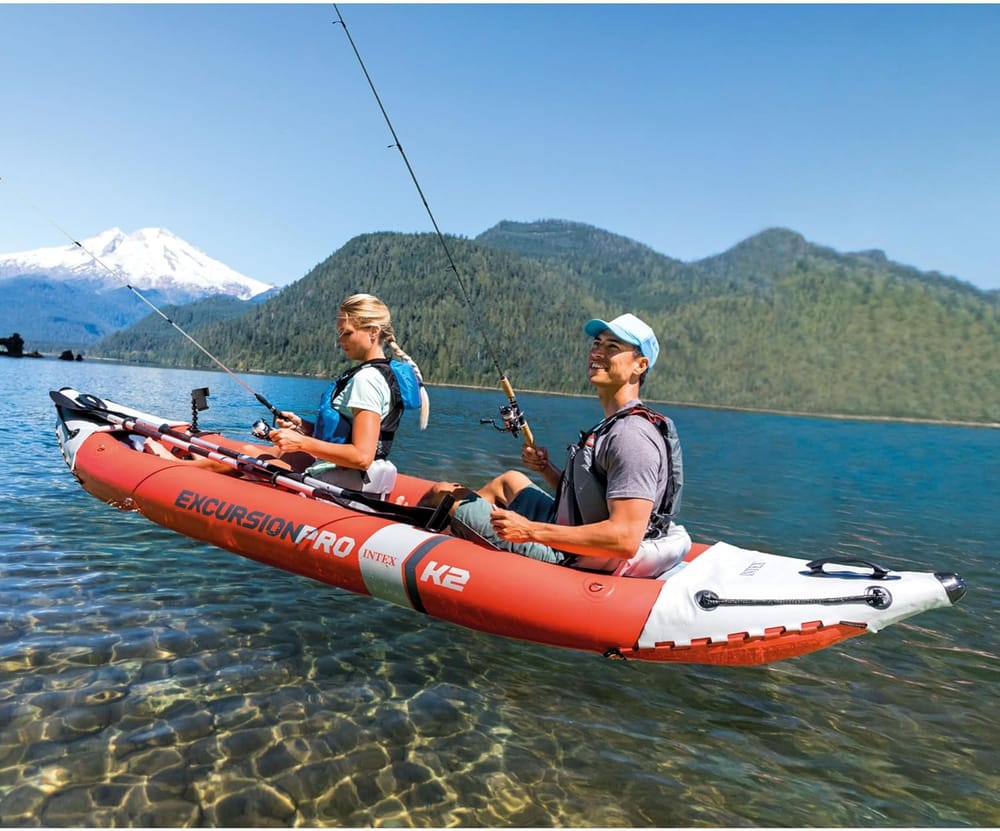What are barefoot shoes?
Barefoot shoes are a type of minimalist shoe or sandal designed to mimic the natural shape and movement of the human foot. Unlike traditional shoes, barefoot shoes have a thin, flexible sole that allows for greater sensory feedback from the ground, promoting a more natural walking or running gait. They typically have a wide toe box to allow the toes to splay naturally and are often lightweight and made from breathable materials. The goal of barefoot shoes is to provide protection while allowing the foot to move as freely and naturally as possible, enhancing balance, posture, and overall foot health.
Living along a rocky Lake Huron shoreline, it's mandatory that we, and all visitors, wear some type of water shoe when entering the lake. We have different types of water shoes and barefoot shoes for different uses.
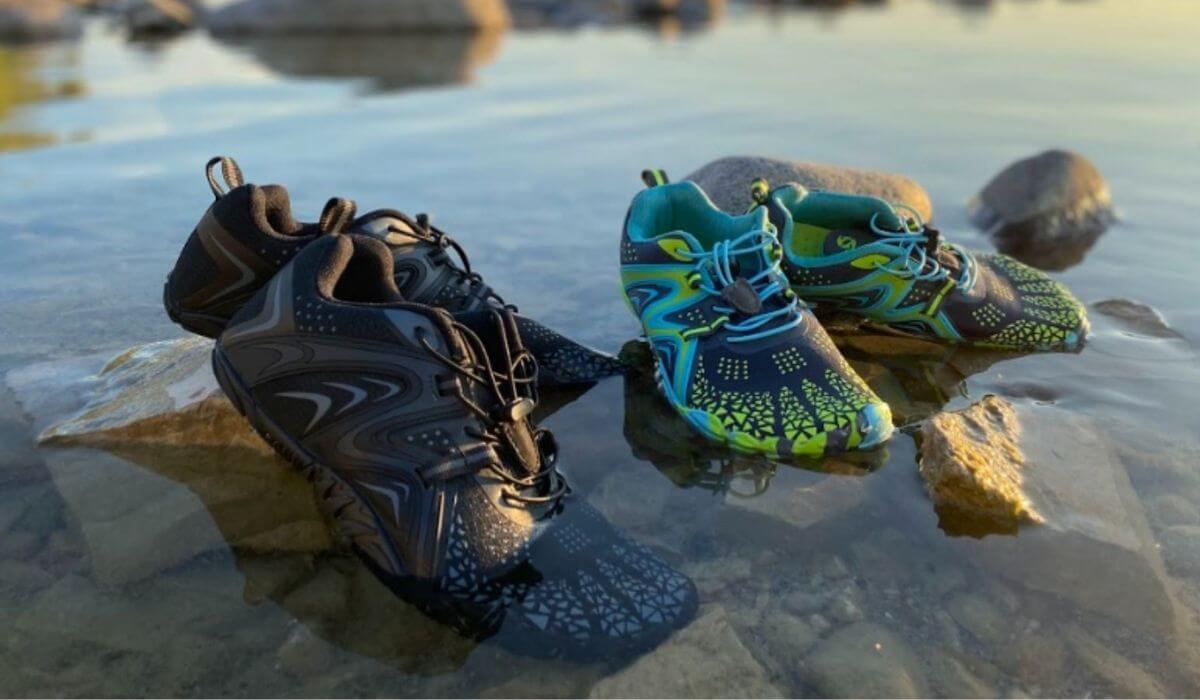
Here's a short list of the different uses we have for water or barefoot shoes:
- walking trails
- morning fitness class
- walking the beach, (can't resist dipping toes in water)
- swimming, aqua shoes
- paddling (paddle boarding or kayaking)
- our 'visitors' basket, with a variety of sizes of water shoes
We aren't a family of runners, but if you enjoy running you will want to try a barefoot shoe for runners too.
What uses do you have for water or barefoot shoes? Knowing how you will be using them will help you determine the best barefoot shoe for you.
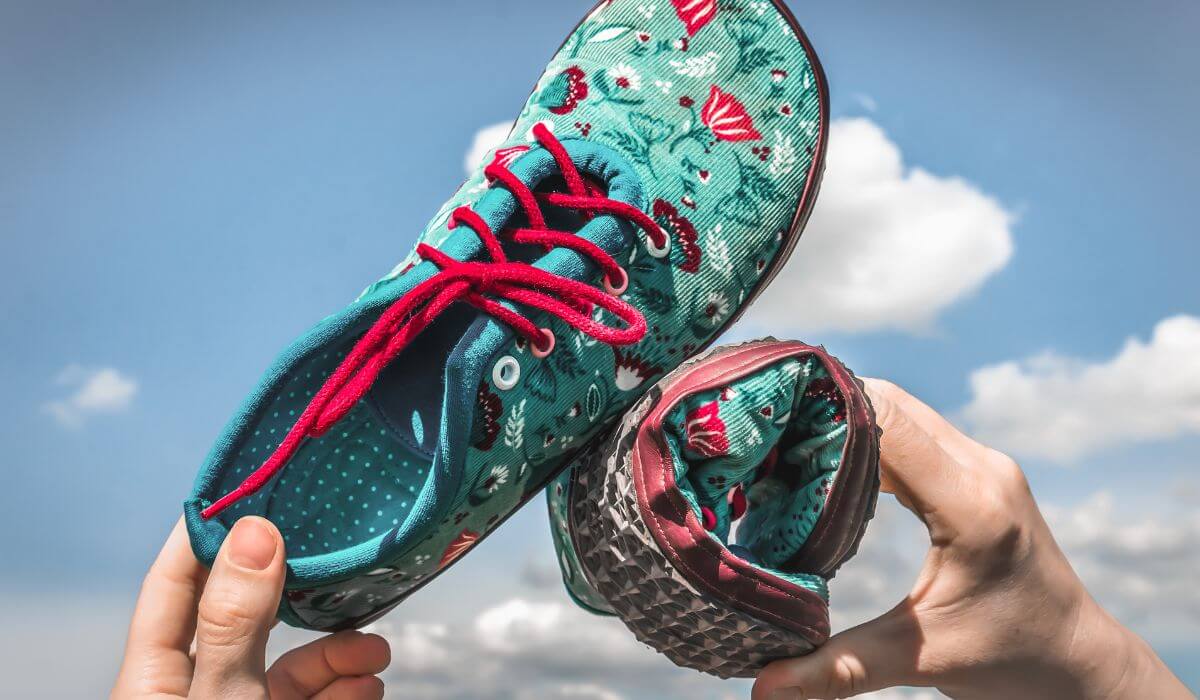
Key Takeaways:
- Understand the different types of barefoot shoes and their specific benefits.
- Consider your lifestyle and activities when selecting a barefoot shoe.
- Prioritize comfort, fit, and functionality over aesthetics.
Introduction to Barefoot Shoes
Barefoot shoes have taken the footwear industry by storm, offering a unique blend of comfort and functionality. These shoes are designed to mimic the natural shape and movement of your feet, providing a more natural walking and running experience. But with so many options available, how do you choose the right type of barefoot shoe for your needs?
In this guide, we'll explore the various types of barefoot shoes, their benefits, and how to select the perfect pair for your lifestyle. Whether you're an avid runner, a casual walker, or someone looking to improve foot health, this guide will help you make an informed decision.
Understanding the Basics of Barefoot Shoes
Barefoot shoes are designed to provide minimal interference with the natural movement of your feet. They typically feature a thin, flexible sole that allows for greater sensory feedback from the ground. This can help improve balance, posture, and overall foot health.
One of the key benefits of barefoot shoes is that they encourage a more natural gait. Traditional shoes often have thick soles and elevated heels, which can alter your walking and running mechanics. Barefoot shoes, on the other hand, promote a midfoot or forefoot strike, reducing the impact on your joints and potentially lowering the risk of injury.
Types of Barefoot Shoes
Minimalist Running Shoes
Minimalist barefoot running shoes are designed for those who want to experience the benefits of barefoot running while still having some protection from the elements. These shoes typically have a thin sole, minimal cushioning, and a lightweight design. They allow for a more natural running form and can help strengthen the muscles in your feet and lower legs.
However, transitioning to minimalist running shoes should be done gradually. Your feet and legs need time to adapt to the reduced cushioning and support. Start with short runs and gradually increase your distance to avoid overuse injuries.
Trail Running Shoes
Trail barefoot running shoes are a great option for those who enjoy running on uneven terrain. These shoes offer the benefits of barefoot running while providing additional protection and grip for off-road conditions. They typically feature a more rugged sole with deeper lugs for better traction on dirt, rocks, and mud.
When choosing barefoot trail running shoes, look for a pair that offers a good balance between flexibility and protection. The sole should be thin enough to allow for natural foot movement but thick enough to protect against sharp objects and rough terrain.
Casual Barefoot Shoes
Casual barefoot shoes are perfect for everyday wear. They offer the same benefits as other barefoot shoes but with a more stylish and versatile design. These shoes can be worn with a variety of outfits, making them a great choice for work, social events, or casual outings.
When selecting casual barefoot shoes, prioritize comfort and fit. Look for a pair with a wide toe box to allow your toes to spread naturally and a flexible sole that moves with your foot. Avoid shoes with excessive cushioning or arch support, as these can interfere with the natural movement of your feet.
Barefoot Sandals
Barefoot sandals are an excellent choice for warm weather and outdoor activities. They provide the benefits of barefoot shoes while allowing your feet to breathe and stay cool. These sandals typically feature a thin, flexible sole and minimal straps to keep your feet secure.
When choosing barefoot sandals, consider the type of activities you'll be doing. For casual wear, look for a simple design with a comfortable fit. For more active pursuits, such as hiking or running, opt for a pair with a more secure fit and additional grip.
Water Shoes
Water shoes are designed for activities in and around water, such as swimming, kayaking, or paddleboarding. These shoes offer the benefits of barefoot footwear while providing protection and grip on wet surfaces. They typically feature a quick-drying material and a non-slip sole.
When selecting best water shoes, look for a pair that fits snugly but comfortably. The material should be breathable and quick-drying to prevent discomfort and blisters. Additionally, ensure the sole provides adequate grip to prevent slipping on wet surfaces.
Factors to Consider When Choosing Barefoot Shoes
Fit and Comfort
The fit and comfort of your barefoot shoes are crucial for a positive experience. A well-fitting shoe should feel like an extension of your foot, allowing for natural movement without causing discomfort. Look for a wide toe box to give your toes room to spread and a flexible sole that moves with your foot.
When trying on barefoot shoes, walk around and pay attention to any areas of discomfort or pressure. The shoes should feel comfortable right out of the box, with no need for a break-in period. If possible, try on shoes at the end of the day when your feet are slightly swollen to ensure a proper fit.
Activity Level and Lifestyle
Your activity level and lifestyle play a significant role in determining the right type of barefoot shoe for you. Consider the types of activities you'll be doing and the environments you'll be in. For example, if you're an avid runner, minimalist or trail running shoes may be the best choice. If you spend a lot of time outdoors, barefoot sandals or water shoes might be more suitable.
Think about how often you'll be wearing the shoes and for what purposes. If you're looking for a versatile option that can be worn daily, casual barefoot shoes are a great choice. For specific activities, such as hiking or water sports, choose a shoe designed for those conditions.
Benefits of Barefoot Shoes
Improved Foot Health
One of the primary benefits of barefoot shoes is improved foot health. Traditional shoes with thick soles and arch support can weaken the muscles in your feet over time. Barefoot shoes, on the other hand, encourage natural movement and help strengthen the muscles, tendons, and ligaments in your feet.
Wearing barefoot shoes can also improve your balance and posture. The increased sensory feedback from the ground helps you become more aware of your body position, leading to better alignment and reduced risk of injury. Additionally, barefoot shoes can help alleviate common foot problems, such as bunions, plantar fasciitis, and flat feet.
Enhanced Performance
Barefoot shoes can enhance your performance in various activities, from running to hiking to everyday walking. The natural movement encouraged by barefoot shoes allows for a more efficient gait, reducing the energy expenditure and improving overall performance. For runners, this can translate to faster times and reduced risk of injury.
In activities like hiking or trail running, barefoot shoes provide better grip and stability on uneven terrain. The increased sensory feedback helps you navigate obstacles more effectively, improving your overall performance and safety. Even in everyday activities, barefoot shoes can make walking and standing more comfortable and efficient.
Transitioning to Barefoot Shoes
Gradual Transition
Transitioning to barefoot shoes should be done gradually to allow your feet and legs to adapt to the new footwear.
According to Dr. Theodore Shybut, Balyor College of Medicine, "if you want to transition to minimalist shoes, it would be best to incorporate them into your regular running schedule gradually. Start with short runs, alternate with your usual shoes, and do low-impact foot and leg strengthening–wobble board, single-leg work, and eccentric exercises."
So, start by wearing your barefoot shoes for short periods and gradually increase the duration as your feet become accustomed to the reduced cushioning and support.
Begin with activities that involve minimal impact, such as walking or light jogging. Pay attention to any discomfort or pain, and give your feet time to rest and recover if needed. As your feet become stronger and more accustomed to the barefoot shoes, you can gradually increase the intensity and duration of your activities.
Summary
Choosing the right type of barefoot shoe involves understanding the different options available and considering your specific needs and lifestyle. From minimalist running shoes to casual barefoot shoes, each type offers unique benefits and features. Prioritize fit, comfort, and functionality to find the perfect pair for your activities.
Barefoot shoes can improve foot health, enhance performance, and provide a more natural and comfortable walking and running experience. By transitioning gradually and paying attention to your body's signals, you can enjoy the many benefits of barefoot footwear.
Happy Adventures!
Your FAV Reviews, Lake Living Essentials team
P.S. - If you haven't seen it yet, check out our Step Up Your Game guide - Step Up Your Game: Lake Life Essentials Guide to 10 of the Best Barefoot Shoes for Lakeside Living
You may also like our story about The Rise of Barefoot Shoes: A Lake Life Essential
FAQ
1. Are barefoot shoes suitable for everyone?
Barefoot shoes can be beneficial for many people, but they may not be suitable for everyone. Individuals with certain foot conditions or those who require additional support may need to consult with a healthcare professional before transitioning to barefoot shoes.
2. How do I know if barefoot shoes are right for me?
If you're interested in improving foot health, enhancing performance, or experiencing a more natural walking and running experience, barefoot shoes may be a good fit for you. Consider your activity level, lifestyle, and any specific foot concerns when making your decision.
3. How long does it take to transition to barefoot shoes?
The transition period can vary depending on the individual and their activity level. It's important to start gradually and listen to your body's signals. For some, the transition may take a few weeks, while others may need several months to fully adapt to barefoot shoes.
Deborah Clarke, a lifelong resident of Lake Huron's shores, founded FAV Reviews in 2022. Her goal is to enhance the lakeside experience for families by recommending quality products they may not have found on their own. As an avid nature lover, Deborah understands the importance of selecting the right products for outdoor activities. FAV Reviews aims to be your go-to source for everything from family-friendly picnic gear to sustainable living essentials.
Whether you're into boating, hiking, or simply enjoying a picnic by the lake, FAV Reviews covers a wide range of products including paddleboards, kayaks, fishing gear, hiking boots, camping tents, swimwear, sun hats, and more. The site also features outdoor furniture, solar-powered lights, and fire pits to enhance your lakeside home. Committed to environmental conservation, FAV Reviews offers eco-friendly recommendations for lakeside living for everything from reusable water bottles to sunscreen.
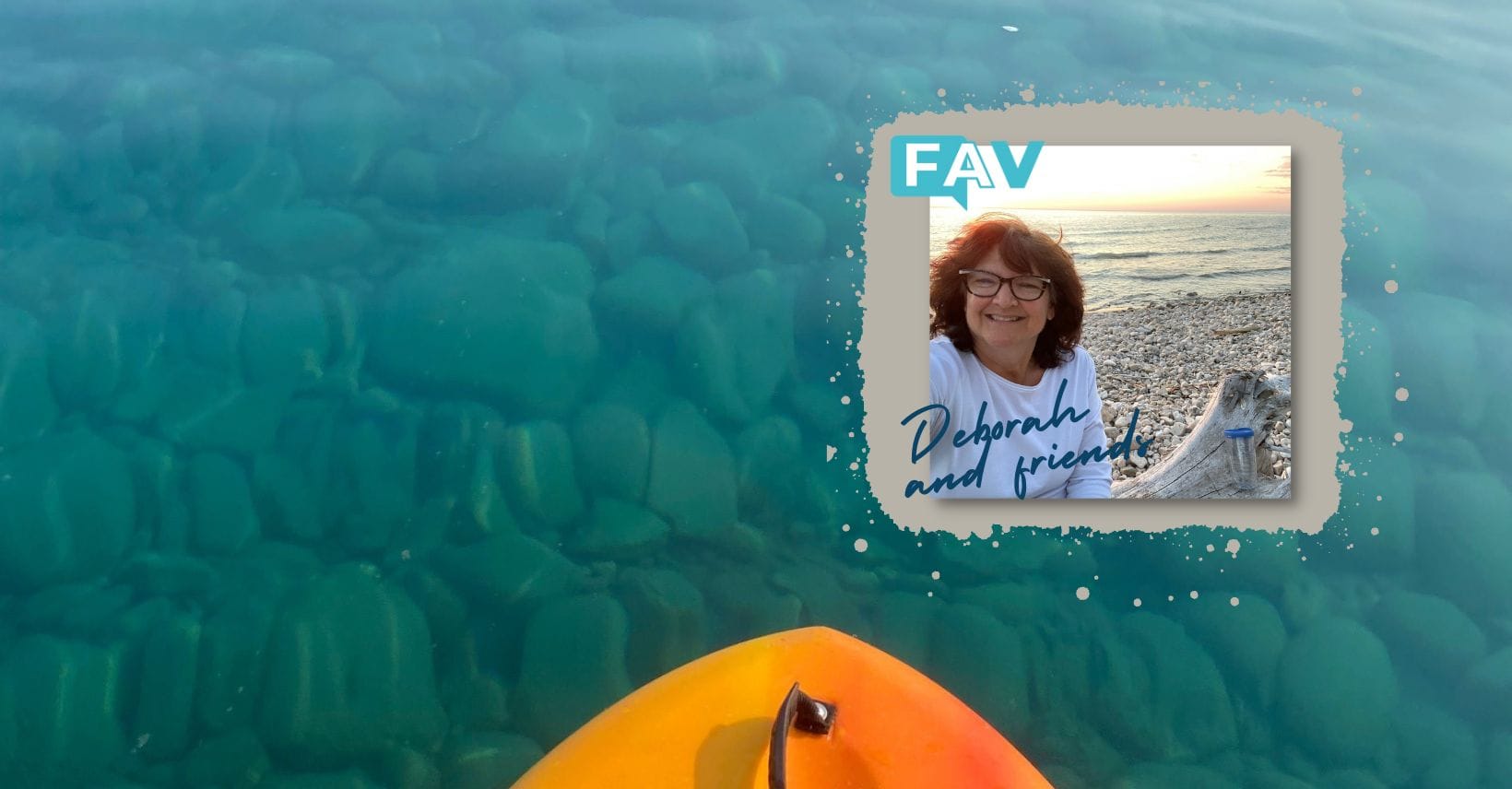
Stay updated with the latest reviews by subscribing to our emails. Click the subscribe button on this page to ensure you never miss out on enhancing your lakeside living experience.
Why Trust Us?
We hope you find your next favorite thing from FavReviews! We are a family friendly product review site.
Four Generation Family: As a four generation family, the breadth of products we consume and review as brand ambassadors is vast. But we can tell you, in general, in we love the outdoors, sports, staying active, living healthy and celebrating the changing seasons.
Trending Products: We also love finding new trending products and we are happy to pass along our research of new trending products to you. Follow us so you don't miss out on a thing! We send out cool emails with our latest reviews, and we will never sell or misuse your information.
Opinions Based on Use, Research and Reviews: Each product we write about is independently selected by our editors. All opinions in this article are our own, based on our own use of the product(s), or hours of research and reading reviews. We will never recommend something we wouldn't use ourselves in our own family.
Compensation: Yes, FavReviews may collect a share of sales or other compensation from the links on this page if you decide to buy something (that's how we stay in business). But, the product never costs you more, in fact in some cases, we hope we might help save you money based on our recommendations.
Reviews have been edited for length and clarity. Enjoy finding your next favorite thing!
Happy Shopping!
Your FavReviews Team
____________________________________________________
BEHIND the SCENES LOOK: If you’d like to learn how to start your own product review blog, with products that you love, check out our article How to Become a Brand Ambassador or visit LearnWriteLive.com There is room for all of us to provide better service to online shoppers. What's your passion?






